Image Dehazing
Image dehazing is the process of removing haze or fog from images to improve their visibility.
Papers and Code
Pruning Overparameterized Multi-Task Networks for Degraded Web Image Restoration
Oct 16, 2025Image quality is a critical factor in delivering visually appealing content on web platforms. However, images often suffer from degradation due to lossy operations applied by online social networks (OSNs), negatively affecting user experience. Image restoration is the process of recovering a clean high-quality image from a given degraded input. Recently, multi-task (all-in-one) image restoration models have gained significant attention, due to their ability to simultaneously handle different types of image degradations. However, these models often come with an excessively high number of trainable parameters, making them computationally inefficient. In this paper, we propose a strategy for compressing multi-task image restoration models. We aim to discover highly sparse subnetworks within overparameterized deep models that can match or even surpass the performance of their dense counterparts. The proposed model, namely MIR-L, utilizes an iterative pruning strategy that removes low-magnitude weights across multiple rounds, while resetting the remaining weights to their original initialization. This iterative process is important for the multi-task image restoration model's optimization, effectively uncovering "winning tickets" that maintain or exceed state-of-the-art performance at high sparsity levels. Experimental evaluation on benchmark datasets for the deraining, dehazing, and denoising tasks shows that MIR-L retains only 10% of the trainable parameters while maintaining high image restoration performance. Our code, datasets and pre-trained models are made publicly available at https://github.com/Thomkat/MIR-L.
RPD-Diff: Region-Adaptive Physics-Guided Diffusion Model for Visibility Enhancement under Dense and Non-Uniform Haze
Aug 23, 2025Single-image dehazing under dense and non-uniform haze conditions remains challenging due to severe information degradation and spatial heterogeneity. Traditional diffusion-based dehazing methods struggle with insufficient generation conditioning and lack of adaptability to spatially varying haze distributions, which leads to suboptimal restoration. To address these limitations, we propose RPD-Diff, a Region-adaptive Physics-guided Dehazing Diffusion Model for robust visibility enhancement in complex haze scenarios. RPD-Diff introduces a Physics-guided Intermediate State Targeting (PIST) strategy, which leverages physical priors to reformulate the diffusion Markov chain by generation target transitions, mitigating the issue of insufficient conditioning in dense haze scenarios. Additionally, the Haze-Aware Denoising Timestep Predictor (HADTP) dynamically adjusts patch-specific denoising timesteps employing a transmission map cross-attention mechanism, adeptly managing non-uniform haze distributions. Extensive experiments across four real-world datasets demonstrate that RPD-Diff achieves state-of-the-art performance in challenging dense and non-uniform haze scenarios, delivering high-quality, haze-free images with superior detail clarity and color fidelity.
Semantic Diffusion Posterior Sampling for Cardiac Ultrasound Dehazing
Aug 24, 2025Echocardiography plays a central role in cardiac imaging, offering dynamic views of the heart that are essential for diagnosis and monitoring. However, image quality can be significantly degraded by haze arising from multipath reverberations, particularly in difficult-to-image patients. In this work, we propose a semantic-guided, diffusion-based dehazing algorithm developed for the MICCAI Dehazing Echocardiography Challenge (DehazingEcho2025). Our method integrates a pixel-wise noise model, derived from semantic segmentation of hazy inputs into a diffusion posterior sampling framework guided by a generative prior trained on clean ultrasound data. Quantitative evaluation on the challenge dataset demonstrates strong performance across contrast and fidelity metrics. Code for the submitted algorithm is available at https://github.com/tristan-deep/semantic-diffusion-echo-dehazing.
Can Large Pretrained Depth Estimation Models Help With Image Dehazing?
Aug 01, 2025Image dehazing remains a challenging problem due to the spatially varying nature of haze in real-world scenes. While existing methods have demonstrated the promise of large-scale pretrained models for image dehazing, their architecture-specific designs hinder adaptability across diverse scenarios with different accuracy and efficiency requirements. In this work, we systematically investigate the generalization capability of pretrained depth representations-learned from millions of diverse images-for image dehazing. Our empirical analysis reveals that the learned deep depth features maintain remarkable consistency across varying haze levels. Building on this insight, we propose a plug-and-play RGB-D fusion module that seamlessly integrates with diverse dehazing architectures. Extensive experiments across multiple benchmarks validate both the effectiveness and broad applicability of our approach.
RetinexDual: Retinex-based Dual Nature Approach for Generalized Ultra-High-Definition Image Restoration
Aug 06, 2025Advancements in image sensing have elevated the importance of Ultra-High-Definition Image Restoration (UHD IR). Traditional methods, such as extreme downsampling or transformation from the spatial to the frequency domain, encounter significant drawbacks: downsampling induces irreversible information loss in UHD images, while our frequency analysis reveals that pure frequency-domain approaches are ineffective for spatially confined image artifacts, primarily due to the loss of degradation locality. To overcome these limitations, we present RetinexDual, a novel Retinex theory-based framework designed for generalized UHD IR tasks. RetinexDual leverages two complementary sub-networks: the Scale-Attentive maMBA (SAMBA) and the Frequency Illumination Adaptor (FIA). SAMBA, responsible for correcting the reflectance component, utilizes a coarse-to-fine mechanism to overcome the causal modeling of mamba, which effectively reduces artifacts and restores intricate details. On the other hand, FIA ensures precise correction of color and illumination distortions by operating in the frequency domain and leveraging the global context provided by it. Evaluating RetinexDual on four UHD IR tasks, namely deraining, deblurring, dehazing, and Low-Light Image Enhancement (LLIE), shows that it outperforms recent methods qualitatively and quantitatively. Ablation studies demonstrate the importance of employing distinct designs for each branch in RetinexDual, as well as the effectiveness of its various components.
Frequency Domain-Based Diffusion Model for Unpaired Image Dehazing
Jul 02, 2025Unpaired image dehazing has attracted increasing attention due to its flexible data requirements during model training. Dominant methods based on contrastive learning not only introduce haze-unrelated content information, but also ignore haze-specific properties in the frequency domain (\ie,~haze-related degradation is mainly manifested in the amplitude spectrum). To address these issues, we propose a novel frequency domain-based diffusion model, named \ours, for fully exploiting the beneficial knowledge in unpaired clear data. In particular, inspired by the strong generative ability shown by Diffusion Models (DMs), we tackle the dehazing task from the perspective of frequency domain reconstruction and perform the DMs to yield the amplitude spectrum consistent with the distribution of clear images. To implement it, we propose an Amplitude Residual Encoder (ARE) to extract the amplitude residuals, which effectively compensates for the amplitude gap from the hazy to clear domains, as well as provide supervision for the DMs training. In addition, we propose a Phase Correction Module (PCM) to eliminate artifacts by further refining the phase spectrum during dehazing with a simple attention mechanism. Experimental results demonstrate that our \ours outperforms other state-of-the-art methods on both synthetic and real-world datasets.
Learning Unpaired Image Dehazing with Physics-based Rehazy Generation
Jun 15, 2025Overfitting to synthetic training pairs remains a critical challenge in image dehazing, leading to poor generalization capability to real-world scenarios. To address this issue, existing approaches utilize unpaired realistic data for training, employing CycleGAN or contrastive learning frameworks. Despite their progress, these methods often suffer from training instability, resulting in limited dehazing performance. In this paper, we propose a novel training strategy for unpaired image dehazing, termed Rehazy, to improve both dehazing performance and training stability. This strategy explores the consistency of the underlying clean images across hazy images and utilizes hazy-rehazy pairs for effective learning of real haze characteristics. To favorably construct hazy-rehazy pairs, we develop a physics-based rehazy generation pipeline, which is theoretically validated to reliably produce high-quality rehazy images. Additionally, leveraging the rehazy strategy, we introduce a dual-branch framework for dehazing network training, where a clean branch provides a basic dehazing capability in a synthetic manner, and a hazy branch enhances the generalization ability with hazy-rehazy pairs. Moreover, we design a new dehazing network within these branches to improve the efficiency, which progressively restores clean scenes from coarse to fine. Extensive experiments on four benchmarks demonstrate the superior performance of our approach, exceeding the previous state-of-the-art methods by 3.58 dB on the SOTS-Indoor dataset and by 1.85 dB on the SOTS-Outdoor dataset in PSNR. Our code will be publicly available.
A PDE-Based Image Dehazing Method via Atmospheric Scattering Theory
Jun 10, 2025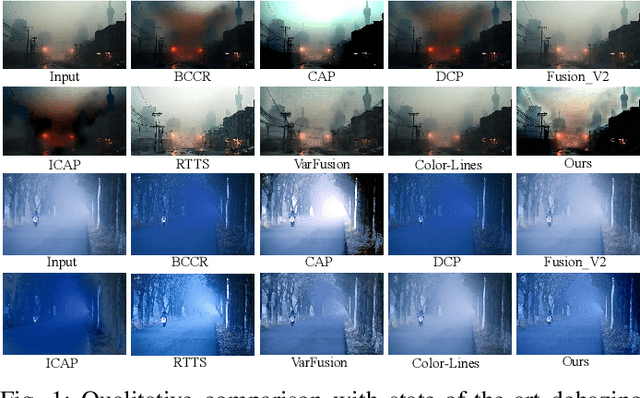
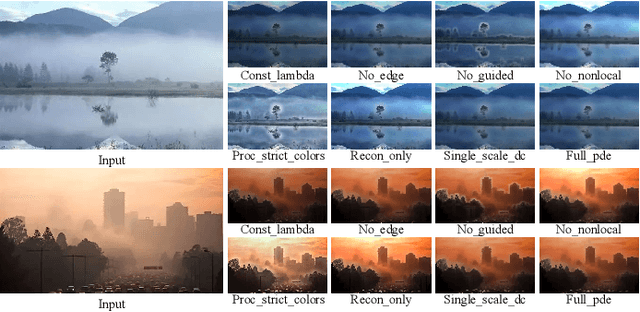
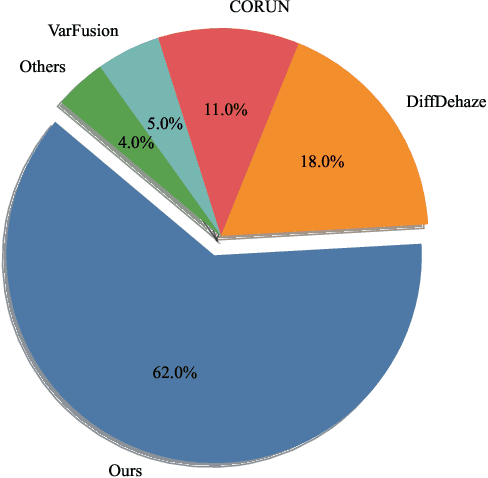
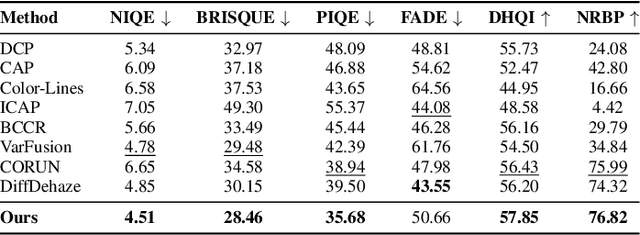
This paper presents a novel partial differential equation (PDE) framework for single-image dehazing. By integrating the atmospheric scattering model with nonlocal regularization and dark channel prior, we propose the improved PDE: \[ -\text{div}\left(D(\nabla u)\nabla u\right) + \lambda(t) G(u) = \Phi(I,t,A) \] where $D(\nabla u) = (|\nabla u| + \epsilon)^{-1}$ is the edge-preserving diffusion coefficient, $G(u)$ is the Gaussian convolution operator, and $\lambda(t)$ is the adaptive regularization parameter based on transmission map $t$. We prove the existence and uniqueness of weak solutions in $H_0^1(\Omega)$ using Lax-Milgram theorem, and implement an efficient fixed-point iteration scheme accelerated by PyTorch GPU computation. The experimental results demonstrate that this method is a promising deghazing solution that can be generalized to the deep model paradigm.
UHD Image Dehazing via anDehazeFormer with Atmospheric-aware KV Cache
May 20, 2025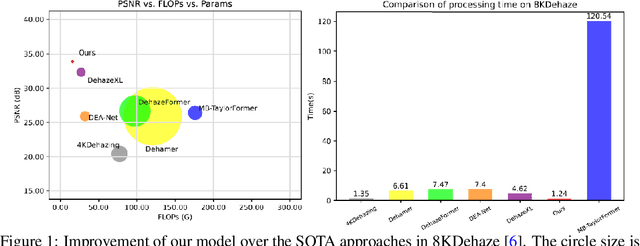



In this paper, we propose an efficient visual transformer framework for ultra-high-definition (UHD) image dehazing that addresses the key challenges of slow training speed and high memory consumption for existing methods. Our approach introduces two key innovations: 1) an \textbf{a}daptive \textbf{n}ormalization mechanism inspired by the nGPT architecture that enables ultra-fast and stable training with a network with a restricted range of parameter expressions; and 2) we devise an atmospheric scattering-aware KV caching mechanism that dynamically optimizes feature preservation based on the physical haze formation model. The proposed architecture improves the training convergence speed by \textbf{5 $\times$} while reducing memory overhead, enabling real-time processing of 50 high-resolution images per second on an RTX4090 GPU. Experimental results show that our approach maintains state-of-the-art dehazing quality while significantly improving computational efficiency for 4K/8K image restoration tasks. Furthermore, we provide a new dehazing image interpretable method with the help of an integrated gradient attribution map. Our code can be found here: https://anonymous.4open.science/r/anDehazeFormer-632E/README.md.
Degradation-Aware Feature Perturbation for All-in-One Image Restoration
May 19, 2025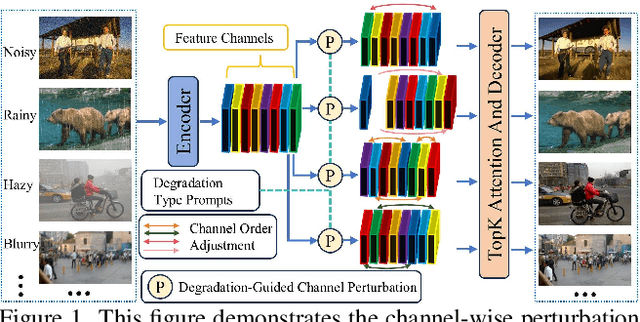

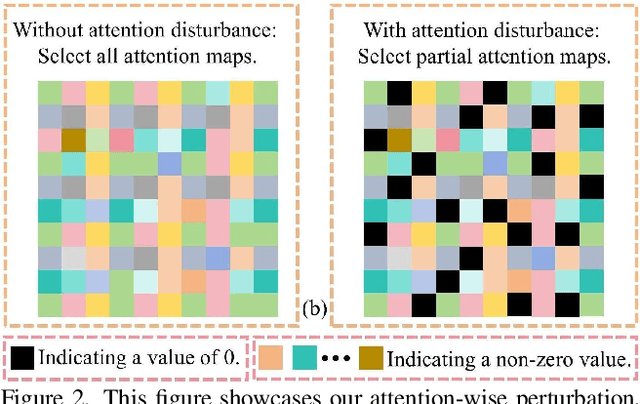
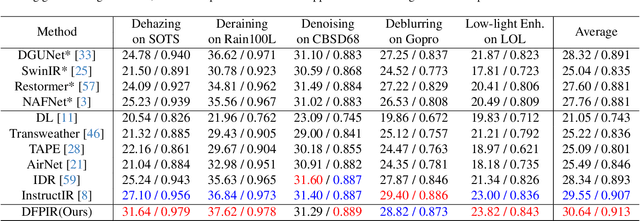
All-in-one image restoration aims to recover clear images from various degradation types and levels with a unified model. Nonetheless, the significant variations among degradation types present challenges for training a universal model, often resulting in task interference, where the gradient update directions of different tasks may diverge due to shared parameters. To address this issue, motivated by the routing strategy, we propose DFPIR, a novel all-in-one image restorer that introduces Degradation-aware Feature Perturbations(DFP) to adjust the feature space to align with the unified parameter space. In this paper, the feature perturbations primarily include channel-wise perturbations and attention-wise perturbations. Specifically, channel-wise perturbations are implemented by shuffling the channels in high-dimensional space guided by degradation types, while attention-wise perturbations are achieved through selective masking in the attention space. To achieve these goals, we propose a Degradation-Guided Perturbation Block (DGPB) to implement these two functions, positioned between the encoding and decoding stages of the encoder-decoder architecture. Extensive experimental results demonstrate that DFPIR achieves state-of-the-art performance on several all-in-one image restoration tasks including image denoising, image dehazing, image deraining, motion deblurring, and low-light image enhancement. Our codes are available at https://github.com/TxpHome/DFPIR.
 Add to Chrome
Add to Chrome Add to Firefox
Add to Firefox Add to Edge
Add to Edge